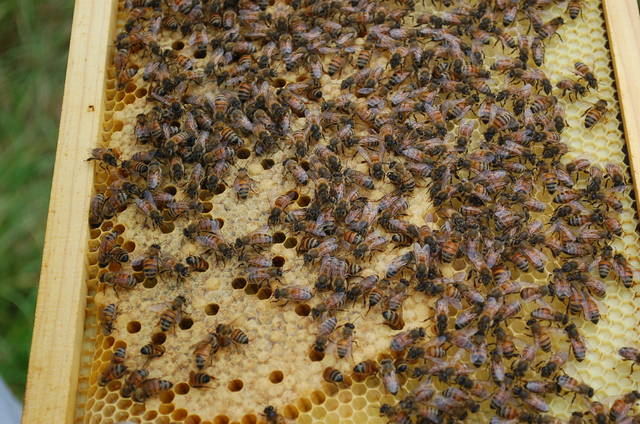
Honey bees are right at home on a comb at a Kauai apiary.
Kauai bees are bringing more than just pollen back into their hives when they return from foraging, according to a recently released, peer- reviewed study published by Kauai scientists.
Glyphosate, also known as Roundup, was in about one-third of honey sampled from store shelves on the island. It was also found in 27 percent of the 59 hives sampled island-wide.
“I did the scientific study to answer the question: Are there pesticides in the environment and how (is it spread),” said Carl Berg, who authored the study with researchers Peter King, Glenda Delenstarr, Ritikaa Kumar, Fernando Rubio and Tom Glaze.
He continued: “Yes. We did find it here on Kauai in the honey from the hives and on the shelves in the store, and it’s closely correlated to large-scale agriculture, which we would assume would be the largest users of Roundup.”
Roundup is also used to control weeds on Kauai’s golf courses, resorts and along the highway, and Berg said those could all be locations where the bees are getting the glyphosate, depending on the location of the hive.
The study also looked at concentration of the herbicide in honey and found the highest concentrations on the Westside, with numbers as high as 179 parts per billion in a sample from a hive.
There is no tolerance limit for glyphosate in honey in the United States. In the European Union, the tolerance level is 50 parts per billion.
“Kilauea is rural and suburbs and open forest and there were no pesticides (in samples) there,” Berg said. “Koloa — it’s suburbs and golf and resort and agriculture and suddenly we get 33 percent of our samples have glyphosate in them.”
The study kicked off with a 2015 science project Kumar did, looking at glyphosate concentration in honey. After she left the island to go to university, Berg continued the research.
He used a new technique called the ELISA technique, developed by Rubio, which is a testing method that is more cost effective than the $500 per sample cost of the traditional testing methods.
“We were looking at glyphosate in water and found it was really expensive to do the tests for glyphosate,” Berg said.
With a more cost-effective way of testing for the pesticide in honey, Berg and his fellow researchers tested the 59 hives and mapped them using geospatial mapping.
They were able to assign land use to the foraging areas around the hives they sampled, which is about a 1 kilometer radius from the hive, and map what type of activities were occurring around each of the hives sampled.
It was Westside hives, closest to seed company and large-scale agriculture operations, that had the most glyphosate. And those hives had the highest concentration of the pesticide in their honey.
Berg said the study wasn’t meant to address questions about the effects of glyphosate in honey or attack any industry. He just wanted to find out if the chemical is being transferred off the fields where it has been sprayed and into the hives and then the honey humans eat.
“Seed crops are using a lot of pesticides,” Berg said. “You can choose where you put your hive and you can draw a circle around where you want to put your bees and see what’s in the circle.”
While Berg and his colleagues have been studying honey and testing for glyphosate, results from a 2014 state-led and County of Kauai commissioned study of the island’s bee pollen showed none of Roundup’s active ingredient.
That’s because the researchers didn’t test for it. Danielle Downey, the state’s apiarist at the time, advised against it.
“She’ll tell you she didn’t test for it because the bees don’t react to it,” said Scott Enright, chairperson of the Department of Agriculture. “Danielle gave them (Hawaii’s bees) a clean bill of health.”
Berg says he wasn’t out to answer the question about the effects of glyphosate on bee health or human health, but to answer the question about the presence of the chemical in hives.
The County of Kauai paid $15,000 for the 2014 study of pollen and wax in hives, but its question was a little bit different than Berg’s. The study looked at the presence of restricted use pesticides in pollen and asked whether the bees were being adversely affected by agriculture pesticide use.
In 2017, Enright reported on the study to County of Kauai.
“The study shows this is not the case,” he told the Kauai County Council during that report.
The 200 individual samples from the 2014 study did show trace amounts of restricted use pesticides like fipronil, which is found in pest control products, though.
While the broad strokes were given to the County of Kauai and announced in public, the data and specifics of the study were given only to the beekeepers who participated in the study.
That’s because it would put the beekeepers’ businesses in jeopardy if it were to be released there were trace amounts of chemicals in their honey.
“It was always stated that we weren’t going to release everybody’s results to the public,” he said.
Downey doesn’t work for the Hawaii DOA anymore: she’s moved on to other apiary-oriented projects, but confirmed each of the 25 participants were provided with complete results of their samples when analysis was done.
“I can say that from the earliest planning stages, protecting the privacy of the beekeepers who agreed to participate by providing pollen samples for the study was of the utmost importance for the project,” Downey said.
••• Jessica Else, environment reporter, can be reached at 245-0452 or at jelse@thegardenisland.com.
read the article here www.thegardenisland.com
